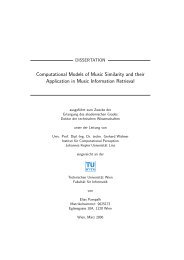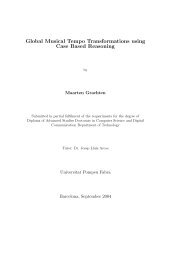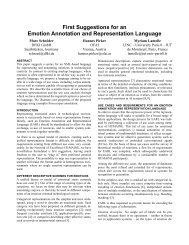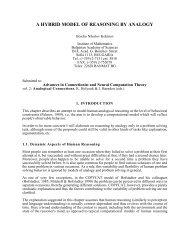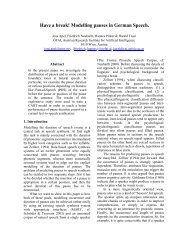Convergent Decomposition Solvers for Tree-reweighted Free ... - OFAI
Convergent Decomposition Solvers for Tree-reweighted Free ... - OFAI
Convergent Decomposition Solvers for Tree-reweighted Free ... - OFAI
You also want an ePaper? Increase the reach of your titles
YUMPU automatically turns print PDFs into web optimized ePapers that Google loves.
<strong>Convergent</strong> <strong>Decomposition</strong> <strong>Solvers</strong> <strong>for</strong> <strong>Tree</strong>-<strong>reweighted</strong> <strong>Free</strong> Energies<br />
Algorithm 1: TightenBound<br />
(SPG Variant)<br />
input : set of trees T and valid distribution ρ, target<br />
parameters θ, arbitrary initial θ ⃗(1) , step size<br />
interval [α min, α max], history length h<br />
output: pseudomarginals µ, upper bound ˜Φ ≥ Φ(θ)<br />
⃗θ (1) ← P θ ( θ ⃗(1) )<br />
˜Φ (1) ← parallelized ∑ T ρ(T )Φ(θ(1) (T ))<br />
α (1) ← 1/‖P θ ( θ ⃗(1) − ∇ (1)<br />
⃗θ<br />
) − θ ⃗(1) ‖<br />
k ← 1<br />
while ‖P θ ( θ ⃗(k) − ∇ (k)<br />
⃗θ<br />
d (k) ← P θ ( θ ⃗(k) − α (k) ∇ (k)<br />
⃗θ<br />
repeat<br />
) − ⃗ θ (k) ‖ < ε do<br />
) − ⃗ θ (k)<br />
choose λ ∈ (0, 1) ; e.g. via interpolation<br />
⃗θ (k+1) ← θ ⃗(k) + λd (k)<br />
˜Φ (k+1) ← parallelized ∑ T ρ(T )Φ(θ(k+1) (T ))<br />
until ˜Φ(k+1) < max{ ˜Φ (k) , . . . , ˜Φ (k−h) } + ɛλ∇ (k) · d<br />
⃗θ<br />
s (k) ← θ ⃗(k+1) − θ ⃗(k)<br />
y (k) ← ∇ (k+1) − ∇ (k)<br />
⃗θ<br />
⃗θ<br />
α (k+1) ← min{α max, max{α min, (s (k)·s (k) )/(s (k)·y (k) )}}<br />
k ← k + 1<br />
return ( ˜Φ (k) , marginals{∇ (k) }) ; see section 3.1<br />
⃗θ<br />
3.4 TIGHTENING THE BOUND<br />
For now, assume that ρ(T ) > 0 <strong>for</strong> a small number of<br />
trees T only. The gradient of our objective in (6) can<br />
then be computed efficiently. Moreover, the constraint<br />
set C(θ) is convex and can be projected onto at little<br />
cost. A principal method <strong>for</strong> optimization in such a<br />
setting is the projected gradient algorithm. However,<br />
this basic method can be improved on.<br />
3.4.1 Spectral Projected Gradient Method<br />
The main improvements of the spectral projected gradient<br />
(SPG) method (Birgin et al., 2000) over classic<br />
projected gradient descent are a particular choice of<br />
the step size (Barzilai and Borwein, 1988) and a nonmonotone,<br />
yet convergent line search (Grippo et al.,<br />
1986). In the setting of unconstrained quadratics, the<br />
SPG algorithm has been observed to converge superlinearly<br />
towards the optimum. We outline its application<br />
to (6) in Algorithm 1. Besides the mandatory<br />
input T , ρ and θ, the meta parameters [α min , α max ]<br />
specify the interval of admissible step sizes, and history<br />
length h specifies how many steps may be taken without<br />
sufficient decrease of the objective. If the number<br />
of steps is exceeded, backtracking is per<strong>for</strong>med<br />
and the step size is decremented until sufficient decrease<br />
has been established. In our implementation,<br />
we chose α min = 10 −10 , α max = 10 10 and h = 10. In<br />
the backtracking step, we simply multiply with a factor<br />
λ = 0.3. In practice, we found Algorithm 1 to be very<br />
robust with respect to the choice of meta parameters.<br />
(a)<br />
(b)<br />
Figure 1: (a) Two “snakes” cover any grid; (b) Two more<br />
mirrored replicas achieve symmetric edge probabilities.<br />
Proposition 1. For a given set of spanning trees T ,<br />
valid distribution over trees ρ and target parameters θ,<br />
Algorithm 1 converges to the global optimum of (6).<br />
Proof (Sketch). Convergence follows from the analysis<br />
of the SPG method by Wang et al. (2005).<br />
3.4.2 Projected Quasi-Newton Method<br />
The projected quasi-Newton (PQN) method was recently<br />
introduced by Schmidt et al. (2009) and can<br />
be considered a generalization of L-BFGS (Nocedal,<br />
1980) to constrained optimization. At each iteration,<br />
a feasible direction is found by minimizing a quadratic<br />
model subject to the original constraints:<br />
min ˜Φ (k) +( θ− ⃗ θ ⃗(k) )·∇ (k)<br />
⃗θ + 1 2 (⃗ θ−θ ⃗(k) ) T B (k) ( θ− ⃗ θ ⃗(k) )<br />
⃗θ∈C(θ)<br />
where B (k) is a positive-definitive approximation to<br />
the Hessian that is maintained in compact <strong>for</strong>m in<br />
terms of the previous p iterates and gradients (Byrd<br />
et al., 1994). The SPG algorithm can be used to<br />
per<strong>for</strong>m the above minimization effectively. We hypothesized<br />
that PQN might compensate <strong>for</strong> the larger<br />
per-iteration cost through improved asymptotic convergence<br />
and thus implemented a scheme similar to<br />
Algorithm 1. We do not give a complete specification<br />
here, as it only differs from Algorithm 1 in the choice<br />
of the direction and the use of a traditional line search.<br />
3.5 CHOOSING THE SET OF TREES<br />
It is clear that Algorithm 1 is only efficient <strong>for</strong> a reasonably<br />
small number of selected trees with ρ(T ) > 0.<br />
We refer to this set as S and denote the corresponding<br />
vector of non-zero coefficients by ρ s . Subsequently, we<br />
discuss how to obtain S and ρ s in a principled manner.<br />
3.5.1 Uni<strong>for</strong>m Edge Probabilities<br />
According to the Laplacian principle of insufficient<br />
reasoning, one might choose uni<strong>for</strong>m edge occurrence<br />
probabilities given by ν st = (|V| − 1)/|E|. However,<br />
in our <strong>for</strong>mulation, we need to find a pair (S, ρ s ) that<br />
results in these probabilities. The dual coupling between<br />
(S, ρ s ) and ν is defined in terms of the map-




